
The Battle off Dagö, 1906
27th April 2023, 2 Comments
Pre-Dreadnought Naval, Perfidious Albion, 1/100 scale
You’ll search long and hard for anything about this battle in the history books. It was, of course, a made-up affair, based around my eclectic collection of hand-built pre-dreadnought models. In this alternative history scrap, in 1905-06 France and Imperial Russia were both at war with Imperial Germany, and two squadrons of Allied battleships had caught a single German one off the Baltic Island of Dagö (now Hiiumaa in Estonia). The Germans had to break past the enemy squadrons, to exit the western (short) table edge, in the direction of Danzig and safety.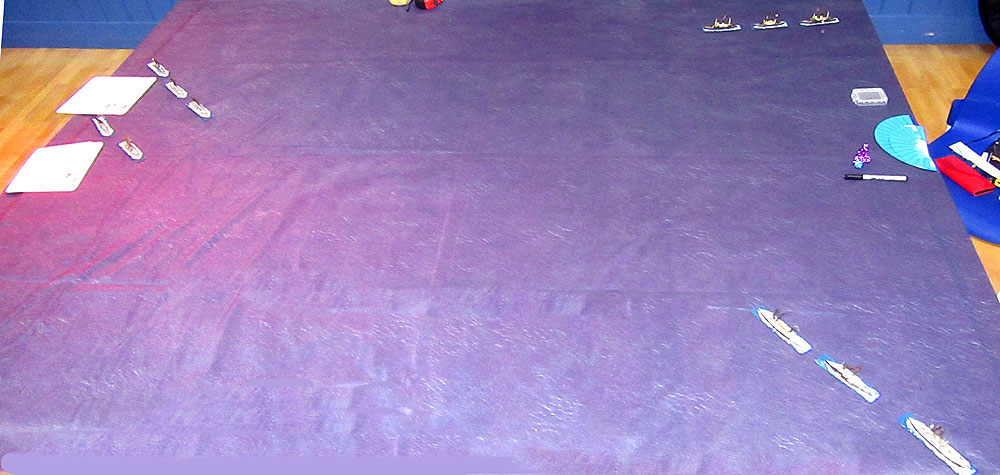 In this battle, Sean 1 commanded the Russian squadron (the battleships Tsessarevitch, Slava and Pantelimon), and Sean 2 the French one (République, Charles Martel and Gaulois), while I took the German squadron (with Hessen, Deutschland and Kaiser Wilhelm der Grosse in one division, and Preussen and Kaiser Freidrich III in the other). In terms of points the Allies had a sizeable edge, but the Germans benefited from their unity -and the fact they were heading in the right direction. The game was played on a 6×6 foot table.
In this battle, Sean 1 commanded the Russian squadron (the battleships Tsessarevitch, Slava and Pantelimon), and Sean 2 the French one (République, Charles Martel and Gaulois), while I took the German squadron (with Hessen, Deutschland and Kaiser Wilhelm der Grosse in one division, and Preussen and Kaiser Freidrich III in the other). In terms of points the Allies had a sizeable edge, but the Germans benefited from their unity -and the fact they were heading in the right direction. The game was played on a 6×6 foot table.  The two Allied squadrons were approaching from the two western table edges, angling in towards the centre of the table. For their part the Germans, entering in the middle of the eastern table edge, immediately angled to starboard, to take on the French first. Admiral Pumpernickel in Preussen had read his history and was essentially repeating the tactics of the Action off Basse-Terre, 1805 (fought a couple of weeks ago)! Admiral Brioche braced himself, while Admiral Brodinsky ordered an increase in steam, so the Russians could catch up. The first shots were fired by the French, turning broadside on and picking on the Hessen at medium range.
The two Allied squadrons were approaching from the two western table edges, angling in towards the centre of the table. For their part the Germans, entering in the middle of the eastern table edge, immediately angled to starboard, to take on the French first. Admiral Pumpernickel in Preussen had read his history and was essentially repeating the tactics of the Action off Basse-Terre, 1805 (fought a couple of weeks ago)! Admiral Brioche braced himself, while Admiral Brodinsky ordered an increase in steam, so the Russians could catch up. The first shots were fired by the French, turning broadside on and picking on the Hessen at medium range. 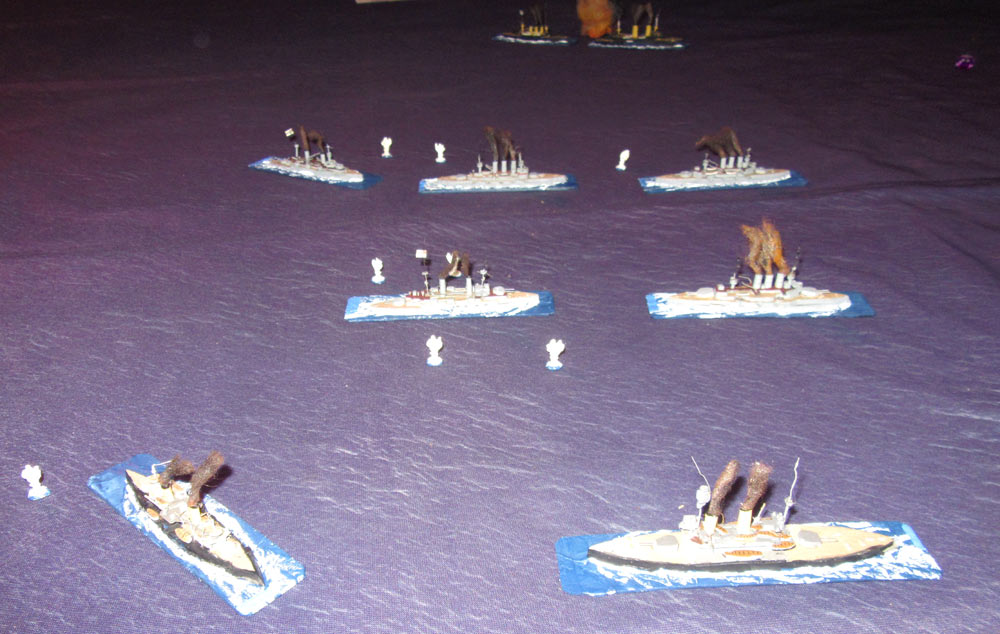 They scored a few hits too, but didn’t hit anything vital – apart from the Hessen’s bridge, killing the German second-in-command, Konteradmiral Stollen and his staff. Still, they also started a fire, which was worrying. Perfidious Albion uses a rather quirky gunnery system, where each gun has a percentage chance of hitting at a certain range, plus or minus a few factors. Hots are worked out by rolling a D10 and a D6, to give a square where the shell landed. If it penetrates the armour there, then you can wreck whatever’s inside. Here’s Pentelimon’s ship card, to show you how it looks.
They scored a few hits too, but didn’t hit anything vital – apart from the Hessen’s bridge, killing the German second-in-command, Konteradmiral Stollen and his staff. Still, they also started a fire, which was worrying. Perfidious Albion uses a rather quirky gunnery system, where each gun has a percentage chance of hitting at a certain range, plus or minus a few factors. Hots are worked out by rolling a D10 and a D6, to give a square where the shell landed. If it penetrates the armour there, then you can wreck whatever’s inside. Here’s Pentelimon’s ship card, to show you how it looks.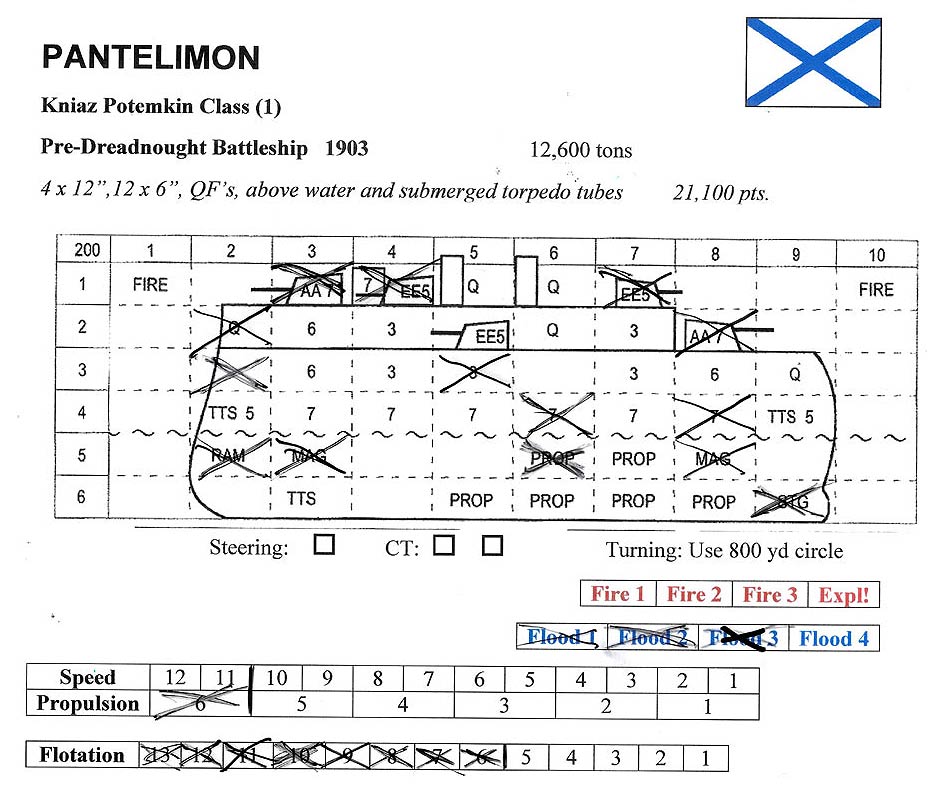 If you have a bow rake you roll 2D6, and a stern rake you so the same, but add +4 to the along D6. Its a simple “old school” system, but it works. It’s also very entertaining! Sometimes you hit fresh air, and other times a magazine. One of the modifiers was crew quality. We made the Germans slightly better than their opponents because the Allies hadn’t operated together before.
If you have a bow rake you roll 2D6, and a stern rake you so the same, but add +4 to the along D6. Its a simple “old school” system, but it works. It’s also very entertaining! Sometimes you hit fresh air, and other times a magazine. One of the modifiers was crew quality. We made the Germans slightly better than their opponents because the Allies hadn’t operated together before. 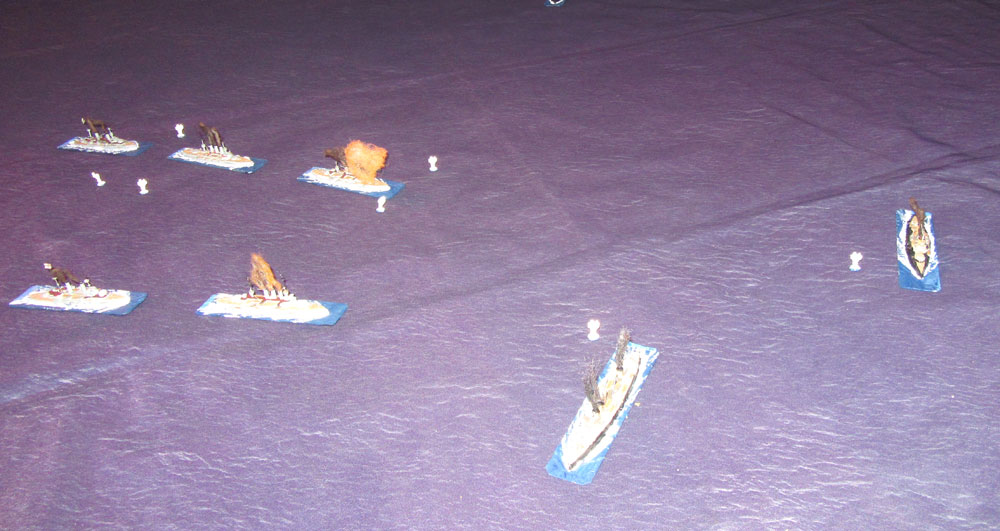 Anyway, as the Germans headed west they kept their two column formation, and the French turned to port to get out of their way. The Russians turned to fire at the German port column at a mile range (16″), and that German column fired back. That left Preussen and Kaiser Freidrich III to keep the French at bay, who were now heading in the wrong direction – east. The Germans were steaming west.
Anyway, as the Germans headed west they kept their two column formation, and the French turned to port to get out of their way. The Russians turned to fire at the German port column at a mile range (16″), and that German column fired back. That left Preussen and Kaiser Freidrich III to keep the French at bay, who were now heading in the wrong direction – east. The Germans were steaming west. 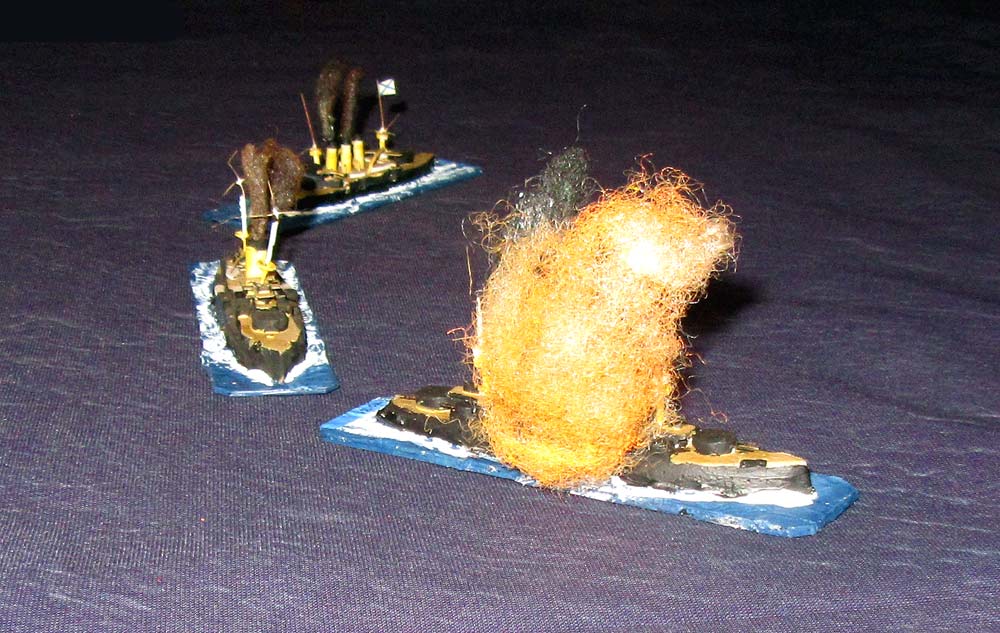 At that moment, as the Russian and German ships pounded each other, that a shell from Hessen struck the forward magazine of Admiral Brodinsky’s flagship Tsessarevitch. She immediately blew up, taking everybody on board with her. With Sean 1’s alter ego blown to smithereens, he now became Captain Nareznoy-Baton of the second Russian ship, Pantelimon.
At that moment, as the Russian and German ships pounded each other, that a shell from Hessen struck the forward magazine of Admiral Brodinsky’s flagship Tsessarevitch. She immediately blew up, taking everybody on board with her. With Sean 1’s alter ego blown to smithereens, he now became Captain Nareznoy-Baton of the second Russian ship, Pantelimon.  Meanwhile, the Germans and the Russians were exchanging fire, with the French finally concentrating on the Kaiser Freidrich III . Some of these salvos were fired at very close range (about 600 yards, or 8″)! So, almost every shell hit. It was close enough too, for the Germans to fire their secondary 6″ guns (labelled E in Perfidious Albion, A is 12″ – all the Allied main guns, B is 11″ – the main German guns, while Cs are 10″, carried in the two oldest German ships. At this range though, almost every shell penetrated.
Meanwhile, the Germans and the Russians were exchanging fire, with the French finally concentrating on the Kaiser Freidrich III . Some of these salvos were fired at very close range (about 600 yards, or 8″)! So, almost every shell hit. It was close enough too, for the Germans to fire their secondary 6″ guns (labelled E in Perfidious Albion, A is 12″ – all the Allied main guns, B is 11″ – the main German guns, while Cs are 10″, carried in the two oldest German ships. At this range though, almost every shell penetrated. 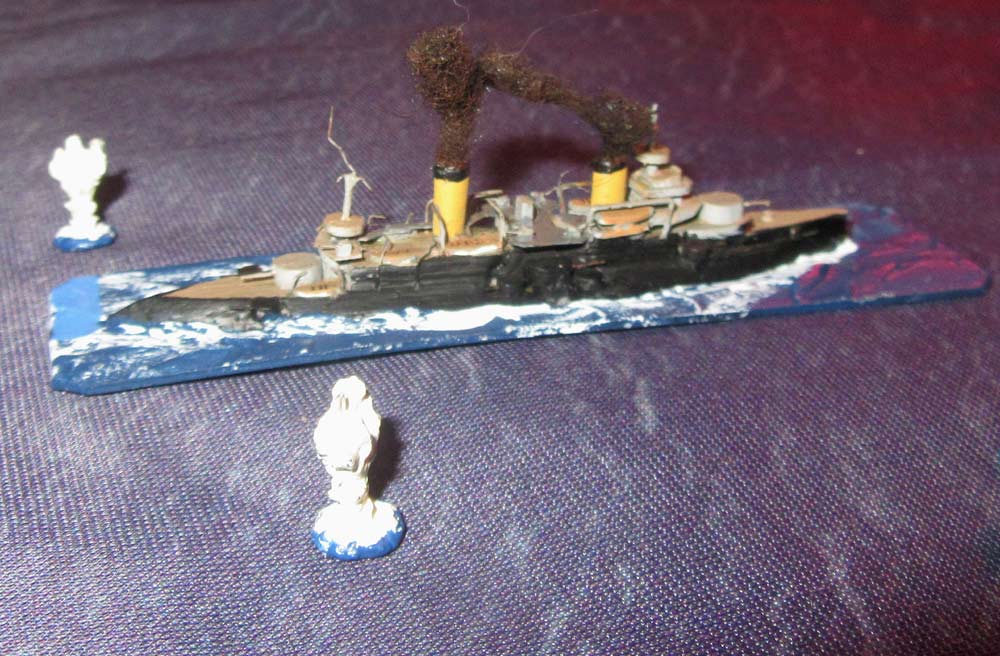 Not surprisingly, bad things began happening. The Russian battleship Pantelimon was first, losing a turret, and prompting Sean to hurriedly flood his magazine. She was flooding badly too, and her damage control teams didn’t seem able to stem the inrush. Her consort Slava was unhurt, but on the Prussian side Hessen lost a turret the same way, and her magazine was promptly flooded too. In the French fleet both Gaulois and Charles Martel (pictured above) lost turrets too, after shell hit their after ammo hoists.
Not surprisingly, bad things began happening. The Russian battleship Pantelimon was first, losing a turret, and prompting Sean to hurriedly flood his magazine. She was flooding badly too, and her damage control teams didn’t seem able to stem the inrush. Her consort Slava was unhurt, but on the Prussian side Hessen lost a turret the same way, and her magazine was promptly flooded too. In the French fleet both Gaulois and Charles Martel (pictured above) lost turrets too, after shell hit their after ammo hoists.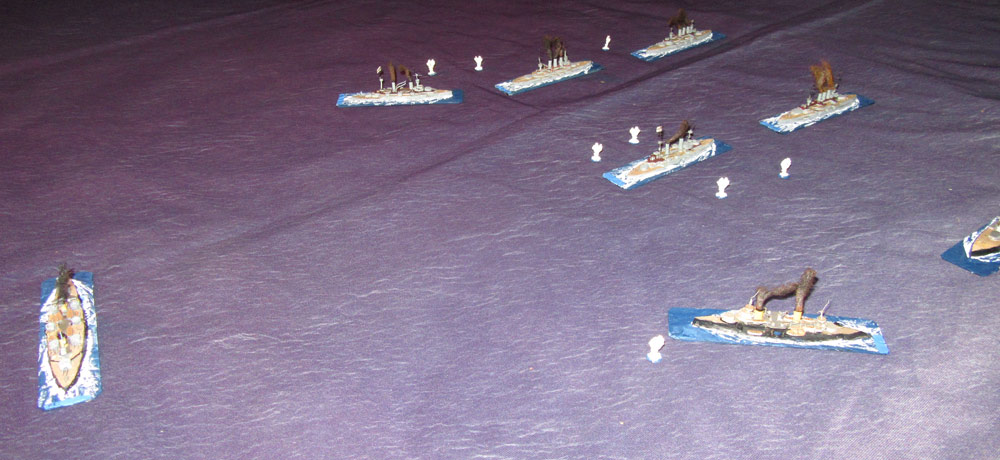 By now the Allied tactics had changed. They seemed unable to stop the Germans reaching the western table edge and safety. So, they picked on the older German ships at the rear, hoping to sink them before the end of the game. So, Deutschland, like Slava, went through the game without suffering scratch, while Kaiser Freidrich II and Kaiser Wilhelm der Grosse were both hit hard, wit the latter losing an after turret, and both being slowed down by multiple hits below the waterline.
By now the Allied tactics had changed. They seemed unable to stop the Germans reaching the western table edge and safety. So, they picked on the older German ships at the rear, hoping to sink them before the end of the game. So, Deutschland, like Slava, went through the game without suffering scratch, while Kaiser Freidrich II and Kaiser Wilhelm der Grosse were both hit hard, wit the latter losing an after turret, and both being slowed down by multiple hits below the waterline.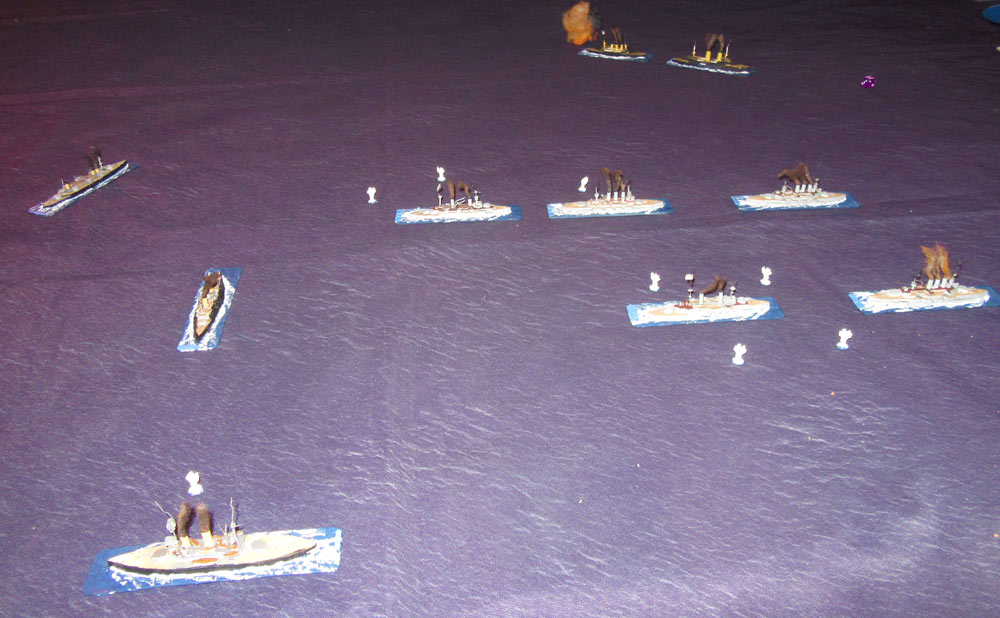 Still, it wasn’t enough. The French were now astern of the Germans – hence picking on the aftermost German ships, but their gunnery had slackened thanks to turret hits. The Russians too, were slowed by hits to Pantelimon, which was leading the way. So, we ended the game when it became clear the Germans were about to make it to safety. It was a fun little scrap, but the only ship sunk was the poor Tsessarevitch, blown up in the opening minutes of the gunnery duel. More importantly though, it was all ridiculously good fun! Somehow the home-made ships like Gaulois (below) looked the part, and suited these very “old school” rules perfectly.
Still, it wasn’t enough. The French were now astern of the Germans – hence picking on the aftermost German ships, but their gunnery had slackened thanks to turret hits. The Russians too, were slowed by hits to Pantelimon, which was leading the way. So, we ended the game when it became clear the Germans were about to make it to safety. It was a fun little scrap, but the only ship sunk was the poor Tsessarevitch, blown up in the opening minutes of the gunnery duel. More importantly though, it was all ridiculously good fun! Somehow the home-made ships like Gaulois (below) looked the part, and suited these very “old school” rules perfectly. 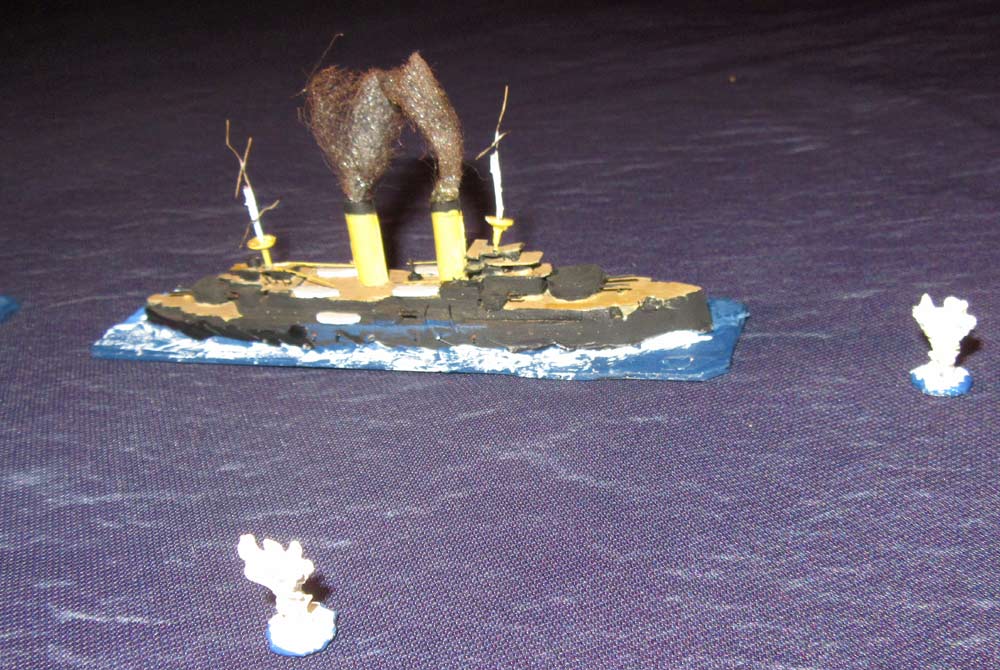





Hand built ,by you? very impressive!
Not by me, Roy. I bought them about twenty years ago from the widow of a modeller. They were too nice to pass up on. The trouble was, he just built one of each class, so you land up with an eclectic bunch of ships!